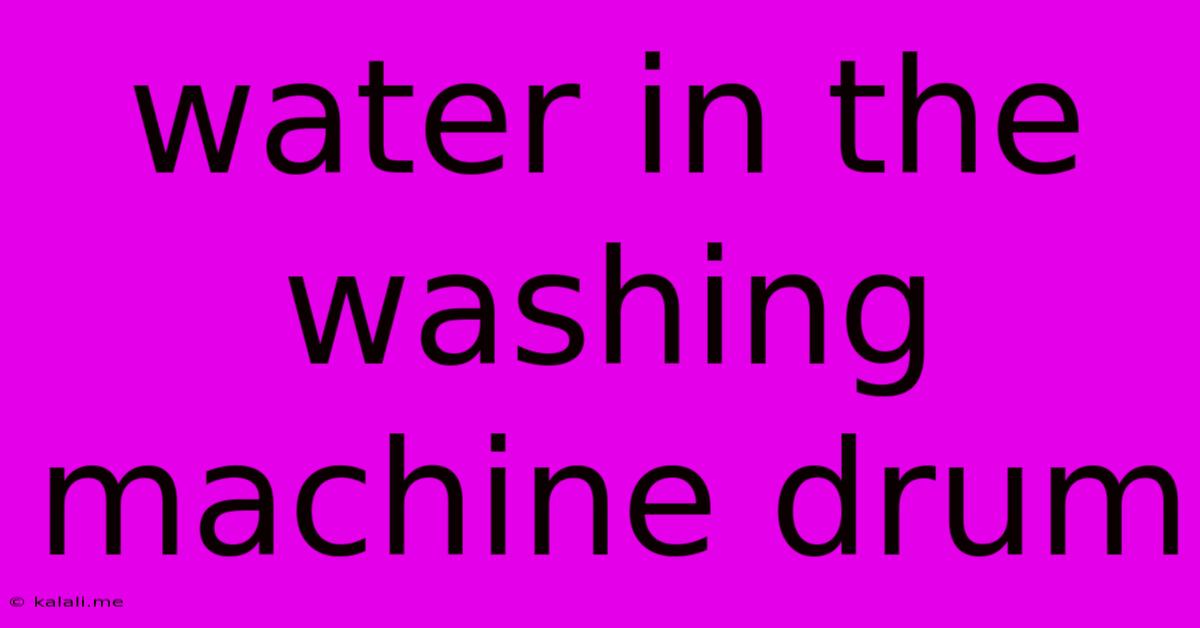Water In The Washing Machine Drum
Kalali
May 21, 2025 · 3 min read

Table of Contents
Understanding the Water in Your Washing Machine Drum: A Comprehensive Guide
Meta Description: Learn all about the water in your washing machine drum – from water levels and pressure to troubleshooting issues and maximizing efficiency. This guide covers everything you need to know for optimal laundry results.
Washing machines are marvels of modern engineering, but understanding the intricacies of their operation can significantly improve laundry efficiency and prolong the appliance's lifespan. A crucial aspect often overlooked is the water itself within the washing machine drum. This article delves into the role of water in your washing machine, exploring water levels, pressure, potential problems, and how to optimize its use for cleaner clothes and a longer-lasting machine.
Water Levels and Their Importance
The amount of water used in each wash cycle directly impacts cleaning effectiveness and energy consumption. Modern washing machines employ various water level sensors and algorithms to determine the appropriate amount of water based on factors like:
- Load size: A larger load necessitates more water to adequately submerge and agitate the clothes.
- Fabric type: Delicate fabrics might require gentler washing with less water to prevent damage.
- Selected wash cycle: Different wash cycles (e.g., delicate, heavy-duty) are programmed with specific water levels optimized for those settings. A heavy-duty cycle will typically use more water than a delicate cycle.
- Water pressure: Sufficient water pressure is crucial for proper water intake and filling. Low water pressure can lead to insufficient water levels, impacting cleaning performance.
Understanding your machine's water level settings and adjusting them according to your laundry needs is key to achieving optimal results while conserving water. Experiment with different settings to find the sweet spot for your laundry habits. Overfilling the drum can lead to inefficient washing, and underfilling can result in poorly cleaned clothes.
Water Pressure and its Influence on Washing Machine Performance
Water pressure significantly influences the washing machine's performance. Insufficient water pressure can manifest in several ways:
- Slow fill times: The machine takes longer to fill with water.
- Inconsistent water levels: The water level may fluctuate during the cycle.
- Poor cleaning results: Insufficient water flow prevents effective cleaning and rinsing.
Conversely, excessively high water pressure can potentially damage internal components over time. While not as common, this is still a factor to consider. If you suspect issues with your water pressure, contact a qualified plumber to check your home's water pressure system. A pressure regulator might be necessary.
Troubleshooting Water-Related Issues
Several problems can arise related to the water in your washing machine drum. Here are some common issues and potential solutions:
- Leaking: Leaks can stem from various sources, including worn-out hoses, faulty seals, or a malfunctioning pump. Leaks necessitate immediate attention to prevent water damage.
- Water not draining: A clogged drain hose or a malfunctioning drain pump can prevent water from draining properly.
- Insufficient water levels: This can be due to low water pressure, a malfunctioning water inlet valve, or a problem with the water level sensor.
- Overfilling: This usually points to a faulty water level sensor or a problem with the control board.
These issues often require professional repair; attempting DIY fixes without adequate knowledge can worsen the problem.
Maximizing Water Efficiency in Your Washing Machine
Several strategies can help maximize water efficiency and reduce your water footprint:
- Choosing the correct water level: Always select the appropriate water level setting based on the load size and type of fabric.
- Using the right amount of detergent: Too much detergent can leave residue on clothes, even with sufficient water.
- Regular maintenance: Cleaning the lint filter and occasionally checking the water inlet filter helps maintain optimal water flow.
- Opting for efficient washing machines: Consider Energy Star certified washing machines that use less water and energy.
- Doing full loads: Washing full loads (but not overcrowding) is more efficient than multiple small loads.
By carefully managing the water used in your washing machine, you contribute to environmental conservation and extend the lifespan of your appliance. Understanding the dynamics of water within the drum is crucial for maximizing efficiency and ensuring optimal laundry results.
Latest Posts
Latest Posts
-
Christ Is Risen He Is Risen Indeed
May 21, 2025
-
Convert From 3 Phase To Single Phase
May 21, 2025
-
Difference Between Mens And Womens Bikes
May 21, 2025
-
Offside Rear Coil Spring Fractured Or Broken
May 21, 2025
-
How Can You Destroy A Horcrux
May 21, 2025
Related Post
Thank you for visiting our website which covers about Water In The Washing Machine Drum . We hope the information provided has been useful to you. Feel free to contact us if you have any questions or need further assistance. See you next time and don't miss to bookmark.